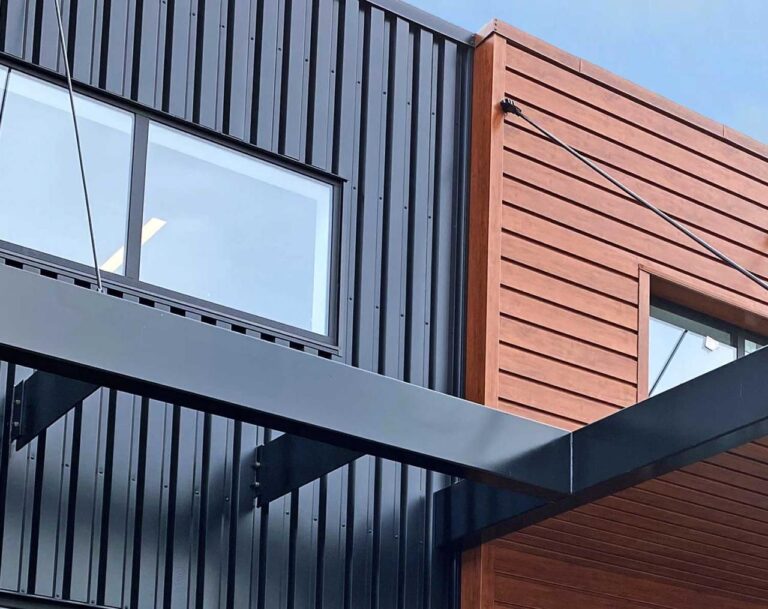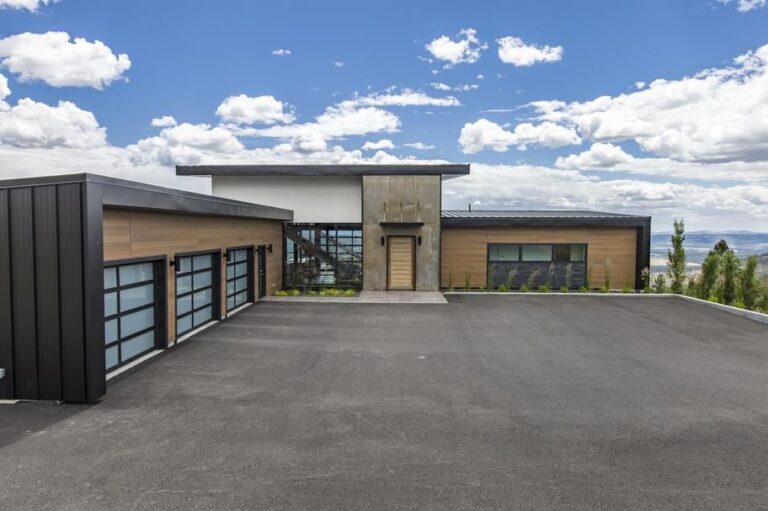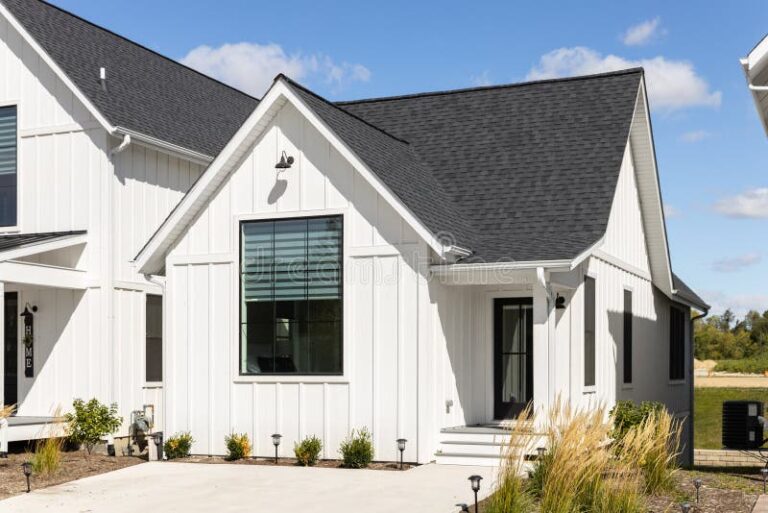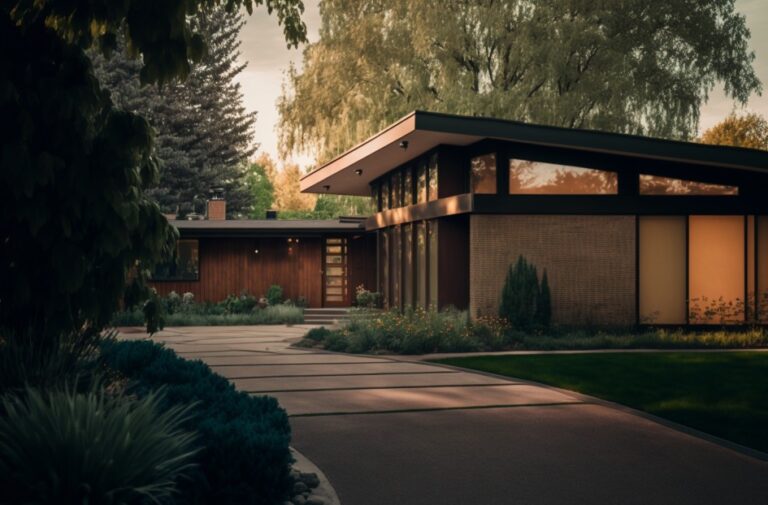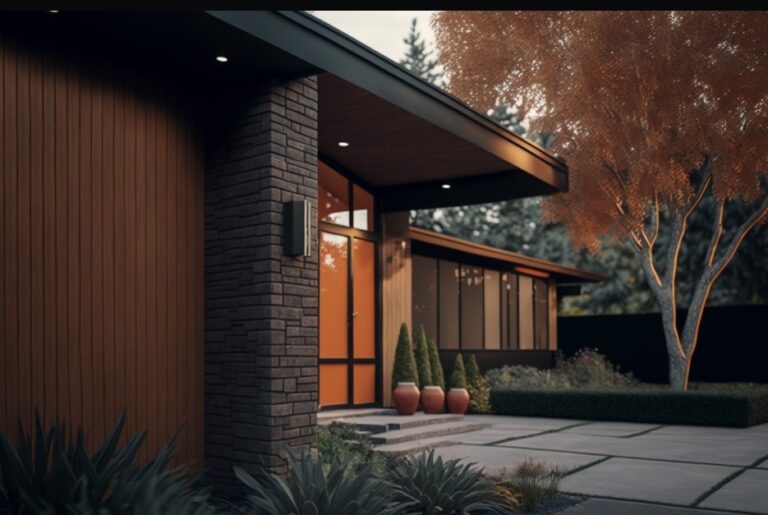Modern Farmhouse Exterior Siding A Comprehensive Guide
Modern farmhouse exterior siding is a key element in achieving a cohesive and stylish aesthetic. This guide explores various siding materials, design elements, finishes, and trends, providing a comprehensive overview of choices and considerations for your project.
From popular materials like wood and vinyl to more contemporary options like fiber cement and metal, we delve into the pros and cons of each. We’ll examine design features, colors, and patterns that harmonize with modern farmhouse architecture, along with essential maintenance and installation procedures. Finally, we’ll address budget-friendly choices without sacrificing quality or visual appeal.
Siding Materials for Modern Farmhouse Exteriors
Modern farmhouse exteriors often prioritize a blend of aesthetic appeal and durability. Selecting the right siding material is crucial for achieving this balance. The material chosen impacts the home’s curb appeal, longevity, and overall maintenance requirements. This discussion will explore popular siding options, their associated benefits and drawbacks, and their respective installation procedures.
Popular Siding Materials
Different siding materials offer unique characteristics. Understanding these properties allows homeowners to make informed decisions aligned with their specific needs and preferences. A wide array of materials, from traditional wood to contemporary metals, are employed in modern farmhouse design.
- Wood Siding: A classic choice, wood siding offers a warm, natural aesthetic. Its inherent beauty and texture can be a significant selling point. However, wood requires regular maintenance, including sealing and painting, to protect it from the elements. Variations exist in wood types, each with its unique properties, such as cedar, pine, and redwood. Proper treatment and maintenance will prolong the lifespan of wood siding.
- Vinyl Siding: Known for its affordability and low maintenance, vinyl siding is a popular option for modern farmhouses. It’s resistant to rot, insects, and warping, minimizing the need for frequent repairs. Vinyl comes in a variety of colors and styles, allowing for customization to match the desired aesthetic. However, it might not have the same visual appeal as natural wood siding.
- Fiber Cement Siding: This composite material combines the durability of cement with the aesthetic flexibility of wood or other siding materials. Fiber cement siding is known for its resistance to rot, insects, and fire. It offers a wide range of colors and textures, allowing for a modern farmhouse design. It’s a popular choice for its long lifespan and relatively low maintenance compared to wood siding.
- Metal Siding: Metal siding, including steel and aluminum, provides exceptional durability and longevity. It’s highly resistant to weather conditions, insects, and fire. Modern metal siding often comes in a variety of colors and finishes, allowing for a modern aesthetic. Installation can be more complex than other options, requiring skilled labor.
Pros and Cons of Each Material
The following table summarizes the comparative advantages and disadvantages of each siding material, considering factors such as cost, durability, maintenance, and aesthetic appeal.
| Material | Cost | Durability | Maintenance | Aesthetic Appeal |
|---|---|---|---|---|
| Wood | Moderate | Good, with proper treatment | High (sealing, painting, repairs) | High (natural beauty) |
| Vinyl | Low | Good, resistant to rot and insects | Low | Moderate (variety of colors and styles) |
| Fiber Cement | Medium | Excellent, resistant to fire, rot, and insects | Low | High (mimics wood or other materials) |
| Metal | High | Excellent, highly durable | Low | Modern, sleek |
Installation Methods
The installation process varies significantly between siding materials. Careful consideration of these differences is crucial for proper installation.
- Wood Siding: Wood siding typically involves nailing or screwing the boards to the framing. Properly spaced and secured boards are critical to prevent warping and damage.
- Vinyl Siding: Vinyl siding is installed by attaching it to the framing using clips or nails. Precise measurements and adherence to manufacturer instructions are essential for a successful installation.
- Fiber Cement Siding: Fiber cement siding is installed similarly to wood siding, using nails or screws. Accurate measurements and proper nailing are crucial to prevent gaps and maintain the structural integrity of the siding.
- Metal Siding: Metal siding requires specialized tools and techniques. A proper framework is necessary to securely fasten the metal panels. Precision in cutting and fitting is essential to achieve a clean, seamless look.
Exterior Design Elements and Siding
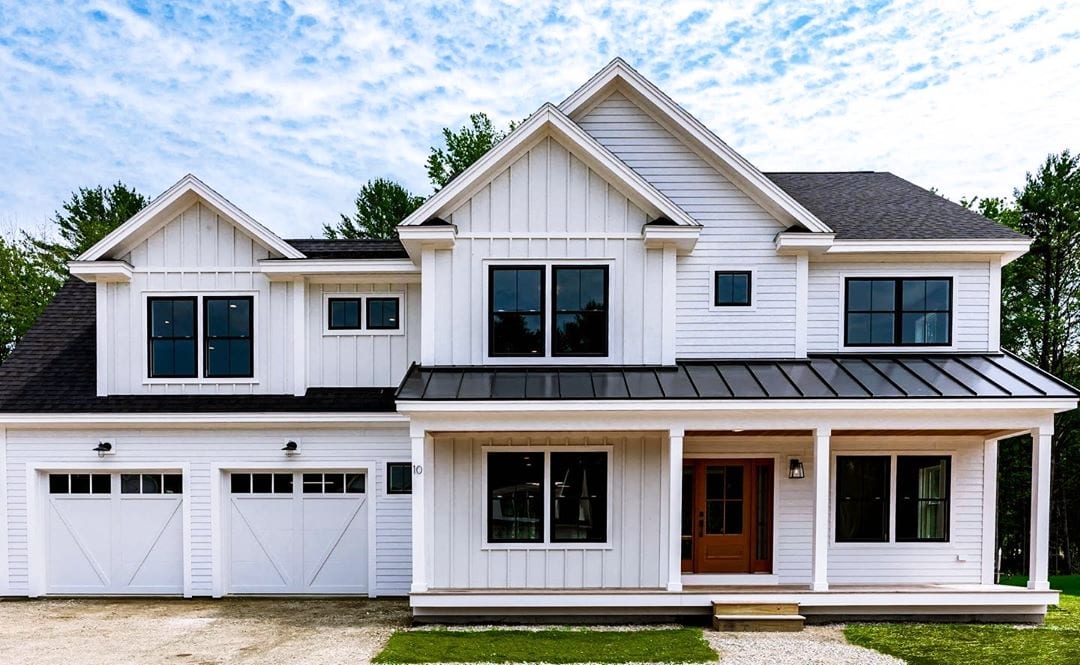
Source: boardandbattensiding.net
Modern farmhouse exteriors blend classic charm with contemporary aesthetics. This fusion often involves thoughtful choices in architectural features and siding materials, culminating in a visually appealing and enduring home. Key elements in these designs include open layouts, exposed beams, and large windows, which are often paired with practical and visually appealing siding solutions.
The selection of siding plays a crucial role in establishing the overall character of a modern farmhouse. Different siding patterns and textures can significantly alter the visual impact of a home, impacting its appeal and personality. The right siding choice enhances the architectural features and creates a harmonious and inviting exterior.
Common Architectural Features
Modern farmhouse designs often incorporate classic elements like wide eaves, gable roofs, and exposed beams, creating a balance between traditional and contemporary styles. These features, when paired with carefully chosen siding, can enhance the visual appeal of the home. Large windows, often spanning the entire facade, are also a common feature, maximizing natural light and creating a spacious feel. The combination of these features contributes to the overall aesthetic of the modern farmhouse.
Siding Patterns and Textures
A variety of siding patterns and textures can be used to complement the architectural features of a modern farmhouse. Horizontal siding, for instance, creates a clean and classic look, while vertical siding adds a more contemporary feel. Shiplap siding offers a distinctive texture and adds warmth and character to the home’s exterior. The choice of pattern should consider the overall style of the home, including its architectural features, and the desired aesthetic effect.
Influence of Siding on Aesthetics
The choice of siding significantly impacts the visual aesthetic of a modern farmhouse. For example, light-colored siding can create a bright and airy feel, while darker colors can provide a more dramatic and sophisticated look. The texture of the siding, whether smooth or textured, also influences the overall aesthetic. The combination of siding color, pattern, and texture can significantly impact the visual appeal and personality of the modern farmhouse.
Exterior Colors for Modern Farmhouses
Neutral colors are often favored for modern farmhouse exteriors. These colors include various shades of gray, beige, and white, which can create a timeless and versatile aesthetic. However, bolder colors, such as soft blues, greens, or warm terracotta, can also be incorporated to add a touch of personality and visual interest. The color palette should be considered about the siding pattern and architectural features.
Siding Patterns and Visual Impact
| Siding Pattern | Visual Impact | Examples |
|---|---|---|
| Horizontal | Creates a clean, classic, and spacious feel. | Wide horizontal boards, evenly spaced. |
| Vertical | Offers a more contemporary and modern look. | Tall, narrow boards are arranged vertically. |
| Shiplap | Provides a distinctive texture and adds warmth and character. | Overlap of boards with a tongue-and-groove joint. |
| Stone Veneer | Adds a rustic and natural touch. | It mimics natural stone with varying textures and colors. |
This table illustrates different siding patterns and their corresponding visual impacts on a modern farmhouse exterior. Each pattern contributes a unique aesthetic, allowing homeowners to personalize their homes while maintaining the overall design cohesion.
Siding Finishes and Treatments
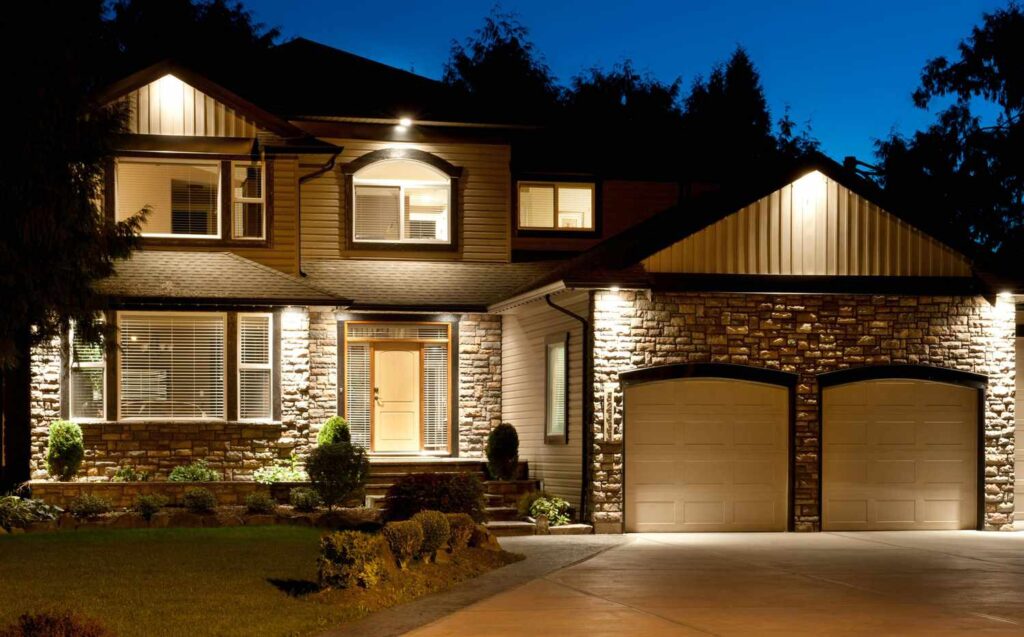
Choosing the right siding finish and treatment is crucial for a modern farmhouse’s longevity and aesthetic appeal. These treatments protect the siding from the elements, impacting both the appearance and durability of the structure. Understanding the nuances of different finishes is key to making informed decisions that align with the desired look and long-term maintenance needs.
Properly applied siding finishes can significantly enhance the lifespan of the siding material. Different finishes react differently to weathering, UV exposure, and moisture, so careful consideration of these factors is essential. This section delves into the various finishes, their impact on durability, and how they contribute to achieving specific aesthetic goals.
Staining Siding
Staining the siding provides a natural look that complements many modern farmhouse designs. Stains penetrate the wood grain, offering a level of protection against moisture and UV damage. However, stains require regular maintenance to retain their effectiveness and beauty. Periodic restaining is necessary to maintain the desired appearance and prevent the wood from deteriorating.
Painting Siding
Painting siding offers a wide range of color options and allows for easy touch-ups and repairs. Paints create a uniform finish and can effectively protect the wood from the elements. The durability of the paint finish depends largely on the quality of the paint used and the proper application techniques. Regular repainting is typically required to maintain the paint’s protective qualities.
Sealing Siding, Modern farmhouse exterior siding
Sealing siding is a crucial preventative measure for moisture penetration and wood rot. Sealants create a protective barrier against moisture and weathering, significantly increasing the longevity of the siding. Sealing can enhance the natural beauty of the wood grain or be used as a preparatory step for staining or painting. Sealants often need to be reapplied periodically, especially after heavy rainfall or other environmental events.
Comparison of Siding Finishes
| Finish | Durability | Appearance | Maintenance | Cost |
|---|---|---|---|---|
| Stained | Moderate, needs regular restaining | Natural wood look | Moderate | Moderate |
| Painted | High repainting intervals depend on paint quality | Wide range of colors | Moderate | Moderate to High |
| Sealed | High; needs resealing periodically | Enhanced wood grain or a base for other finishes | Low to Moderate | Moderate |
Note: Durability ratings are relative and can vary based on the specific product used and application. Maintenance needs depend on the specific conditions and environmental factors in the region where the house is located.
Modern Farmhouse Siding Styles and Trends
Modern farmhouse exteriors often feature siding choices that balance rustic charm with contemporary aesthetics. This section delves into current siding trends, exploring their appeal and role in achieving a cohesive modern farmhouse look. The key is to find a siding style that complements the overall design, highlighting its architectural features and creating a visually appealing exterior.
The popularity of the modern farmhouse style has led to a wide array of siding options. Homeowners are seeking to create homes that are both visually striking and functional, leading to the evolution of different siding choices. This evolution has been driven by a desire for versatility and durability, allowing homeowners to find the perfect siding to express their unique style.
Current Trends in Modern Farmhouse Siding
Modern farmhouse siding often leans toward materials that offer a balance of durability, aesthetic appeal, and cost-effectiveness. Natural wood, stone, and fiber cement are popular choices, with a notable rise in the use of composite materials. The trend emphasizes a thoughtful combination of materials and textures to create a cohesive and timeless exterior.
Reasons for the Popularity of Specific Siding Styles
Several factors contribute to the popularity of particular siding styles in modern farmhouse design. The desire for a warm, inviting aesthetic often leads to the use of natural materials like wood or stone. Fiber cement, while synthetic, mimics the look and feel of natural materials with enhanced durability. These materials also often offer a range of color options, allowing for greater customization.
Siding’s Role in Creating a Modern Farmhouse Aesthetic
Siding plays a crucial role in establishing the overall aesthetic of a modern farmhouse. The material’s texture, color, and pattern contribute to the building’s visual appeal. Well-chosen siding can emphasize the home’s architectural features, creating a cohesive and harmonious design. A strong siding choice can define the architectural style and create a distinctive front-facing element.
Examples of Different Siding Styles in Modern Farmhouse Exteriors
Many modern farmhouse exteriors utilize a combination of siding materials to achieve a balanced and sophisticated look. For example, board-and-batten siding offers a classic, rustic appeal that complements the farmhouse aesthetic. Stone accents or stucco, used strategically, can add depth and visual interest. The use of shakes or shiplap siding, in carefully considered applications, creates a striking contrast. These are not mutually exclusive, and many homes use a mix to add visual interest and create a layered look.
Table of Siding Styles and Architectural Characteristics
| Siding Style | Architectural Characteristics | Examples |
|---|---|---|
| Board and Batten | Classic, rustic, creates a textured appearance. Often used in combination with other materials for a layered effect. | A modern farmhouse with a mix of board and batten and stone accents. |
| Shiplap | Creates a clean, modern look with horizontal lines. Can be used as a feature wall or throughout the entire exterior. | A modern farmhouse with a large expanse of shiplap, complemented by a contrasting color. |
| Stone | Provides a natural, timeless appeal. It can be used as a feature wall or as accents. | A modern farmhouse with a stone veneer accent wall or fireplace. |
| Stucco | Provides a smooth, versatile surface that can be painted in a variety of colors. Offers a modern, contemporary aesthetic. | A modern farmhouse with a stucco exterior in a light, neutral color. |
| Fiber Cement | It is a durable, low-maintenance option that mimics natural materials. Available in a variety of textures and colors. | A modern farmhouse with fiber cement siding, designed to resemble wood shakes. |
| Wood Shakes | Adds a natural, organic touch. Often used for accent walls or roofing. | A modern farmhouse with a portion of the exterior covered in wood shakes in a muted tone. |
Maintenance and Repair Considerations: Modern Farmhouse Exterior Siding
Maintaining the aesthetic appeal and structural integrity of your modern farmhouse exterior requires proactive care and attention to detail. Proper maintenance extends the lifespan of your siding, minimizes costly repairs, and preserves the home’s curb appeal. Understanding the specific needs of various siding materials is key to effective upkeep.
Maintenance Procedures for Different Siding Materials
Different siding materials necessitate distinct maintenance approaches. Careful attention to these details will ensure long-term performance and beauty. For example, vinyl siding, while generally low-maintenance, still benefits from regular cleaning and inspection. Wood siding, though beautiful, demands more frequent treatment to protect it from the elements.
- Vinyl Siding: Regular cleaning with mild soap and water is crucial. Avoid harsh chemicals that can damage the vinyl’s surface. Inspect for any signs of damage, such as cracks or warping, and address them promptly. A simple visual check can prevent more significant problems.
- Fiber Cement Siding: Fiber cement is remarkably durable. However, regular washing with a garden hose and mild detergent is still recommended. Inspect for any loose or damaged panels and address them promptly. Avoid using abrasive cleaners, which can scratch the surface.
- Wood Siding: Regular cleaning with a soft brush and mild soap solution is essential. Inspect for any signs of rot, insect infestation, or damage from weather. Periodic sealing and staining are crucial for maintaining its aesthetic appeal and longevity. Consider using a sealant or stain that matches the original finish to maintain the appearance.
- Stone Veneer Siding: Stone veneer is generally low-maintenance. However, regular washing with a garden hose and mild detergent can help remove dirt and grime. Inspect for any signs of cracking, damage, or displacement and repair them promptly. Using a soft brush or sponge is advisable for cleaning.
Identifying and Addressing Common Siding Issues
Prompt identification and resolution of siding issues are essential for preventing further damage. Early detection of problems can save significant expenses and maintain the visual appeal of the home.
- Cracks and Warping: Cracks and warping in vinyl or wood siding can result from extreme weather conditions or structural issues. Inspect the siding regularly for these signs, and address any damage promptly to prevent further deterioration. A qualified contractor can assess the structural integrity of the affected areas.
- Mold and Mildew: Mold and mildew growth can occur in damp or shaded areas, especially on vinyl or wood siding. Regular cleaning and prompt treatment of affected areas are essential to prevent further spread and maintain the aesthetic appeal of the siding. Using a mildewcide solution, if necessary, should be done with caution, following manufacturer instructions.
- Loose or Damaged Panels: Loose or damaged panels in any siding material can result from impact or weather exposure. Regular inspection can identify these problems before they escalate. Prompt repair is essential to prevent further damage and maintain the structure’s integrity.
Choosing the Right Repair Methods
Appropriate repair methods are crucial for ensuring the longevity and visual appeal of the siding. Using the wrong technique can lead to further damage or compromise the siding’s integrity. Thorough research and careful planning are essential.
- Vinyl Siding Repairs: Small cracks or holes can often be repaired with a suitable vinyl patching compound. Larger repairs may require the replacement of the damaged panel. Consult with a professional for more extensive repairs.
- Fiber Cement Siding Repairs: Fiber cement siding is typically durable. However, if damage occurs, the damaged area may need to be replaced with a matching panel. Repairing with patching compounds is possible in minor cases, but professional guidance is highly recommended.
- Wood Siding Repairs: Wood rot, insect infestation, or other damage requires careful treatment. The damaged area may need to be replaced, or specialized treatments might be necessary. Consult a professional for extensive repairs.
- Stone Veneer Repairs: Cracked or displaced stone veneer pieces should be carefully repaired by a qualified contractor to ensure proper alignment and structural stability. The repair method should match the original stone’s characteristics to maintain the visual appeal.
Typical Maintenance Tasks and Summary Table
Consistent maintenance tasks and a regular schedule are essential for long-term siding health and appearance. This proactive approach ensures minimal repairs and protects the investment in your modern farmhouse.
- Vinyl Siding: Regular washing with mild soap and water, checking for cracks or warping, and addressing any damage promptly.
- Fiber Cement Siding: Washing with a garden hose and mild detergent, inspecting for loose panels, and promptly repairing any damage.
- Wood Siding: Cleaning with a soft brush and mild soap, checking for rot or insect infestation, and sealing or staining periodically.
- Stone Veneer Siding: Wash with a garden hose and mild detergent, inspect for cracks or displacement, and promptly repair any damage.
| Siding Material | Maintenance Task | Frequency | Required Tools |
|---|---|---|---|
| Vinyl | Washing, Inspection | Quarterly | Soft brush, mild soap, water, utility knife |
| Fiber Cement | Washing, Inspection | Semi-annually | Garden hose, mild detergent, putty knife |
| Wood | Washing, Inspection, Sealing/Staining | Annually | Soft brush, mild soap, water, sealant/stain, ladder |
| Stone Veneer | Washing, Inspection | Semi-annually | Garden hose, mild detergent, soft brush, sponge |
Siding Installation Considerations
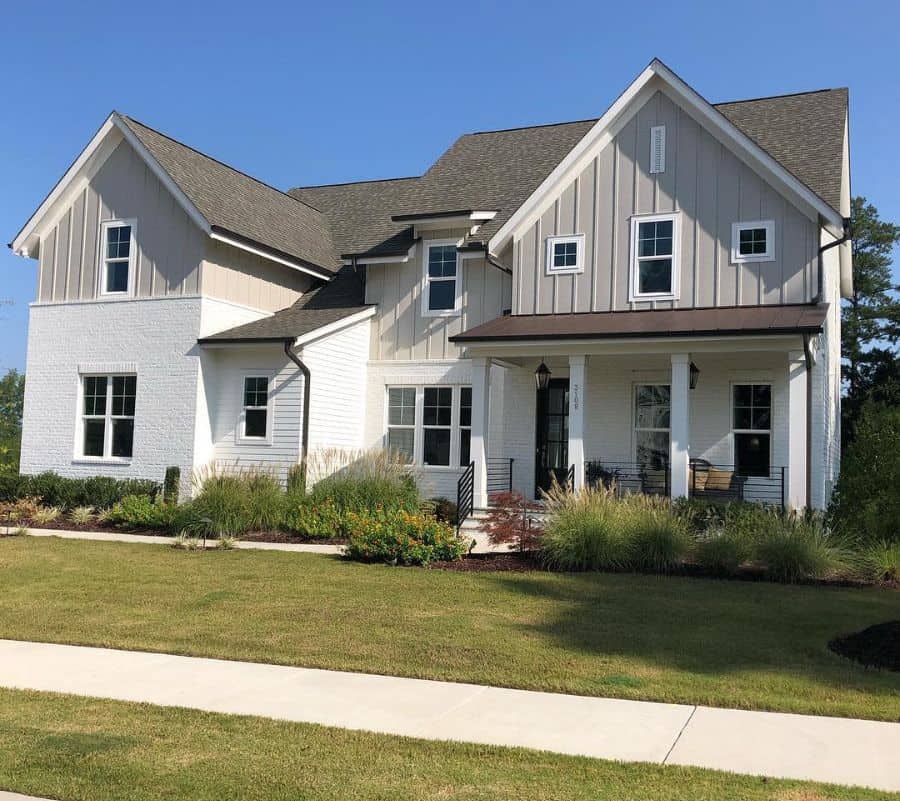
Source: nextluxury.com
Proper siding installation is crucial for the longevity and aesthetic appeal of a modern farmhouse. Careful planning and execution, from initial preparation to final touches, are vital for a successful project. Understanding the nuances of weather conditions and local building codes and employing qualified contractors are key factors in achieving a high-quality result.
Careful consideration of these factors ensures a durable and attractive siding installation that will withstand the test of time. Proper preparation and meticulous installation techniques minimize the risk of future issues. Choosing a qualified contractor is also essential to ensure the job is completed to the highest standards and ibylocal regulations.
Weather Conditions and Building Codes
Weather patterns significantly impact siding installation. Extreme temperatures, heavy rainfall, or high winds can affect the adhesive properties of the sealant, the integrity of the substrate, and the overall installation quality. Local building codes dictate crucial aspects such as material specifications, installation techniques, and safety precautions. Understanding these regulations prevents costly errors and ensures the structure’s compliance with safety standards. Thorough research into local climate patterns and code requirements is critical before commencing installation.
Preparation and Installation Techniques
Proper preparation of the substrate is paramount for a successful siding installation. This includes cleaning the existing surface to remove debris, ensuring proper moisture control, and verifying the structural integrity of the walls. Adherence to specific installation techniques is crucial for achieving optimal results. These techniques, which include using appropriate fasteners, adhesives, and sealants, guarantee the long-term stability and durability of the siding. Incorrect installation methods can lead to issues such as gaps, leaks, and premature material degradation.
Importance of Qualified Contractors
Employing qualified contractors is essential for a successful siding installation. These professionals possess the necessary expertise, knowledge of building codes, and experience to execute the project effectively. They are adept at handling complex situations, ensuring adherence to safety protocols, and utilizing the correct tools and materials. Furthermore, they offer warranty options and support, potentially saving the homeowner time and resources in the long run. Selecting a contractor with a proven track record and positive reviews from past clients is a wise decision.
Potential Problems and Solutions
During installation, various issues can arise. For example, improper substrate preparation can lead to inadequate adhesion, causing the siding to detach over time. Incorrect sealant application can result in leaks and water damage. Improperly installed fasteners can compromise the structural integrity of the siding. Addressing these potential issues promptly, such as by re-applying sealant or using stronger fasteners, minimizes the impact on the project’s overall success. Regular inspections throughout the installation process can prevent the escalation of minor problems.
Siding Installation Steps
| Step | Description |
|---|---|
| 1. Preparation | Thoroughly clean the existing surface, ensuring proper moisture control and structural integrity. Inspect for any damage or imperfections and address them before proceeding. Verify compliance with local building codes and obtain necessary permits. |
| 2. Framing and Flashing | Ensure the framing is in good condition and properly supports the siding. Install necessary flashing around windows, doors, and other openings to prevent water penetration. |
| 3. Installation | Install the siding panels according to the manufacturer’s instructions, adhering to the correct spacing and techniques. Use appropriate fasteners and sealants for a durable and weather-resistant installation. |
| 4. Finishing | Inspect the completed installation for any gaps, overlaps, or imperfections. Address any issues with caulking or additional sealant. Ensure all connections are tight and secure. |
| 5. Final Inspection | Conduct a final walkthrough to ensure the installation meets all specifications and codes. Document any findings and address any outstanding concerns. |
Visual Appeal and Siding Integration
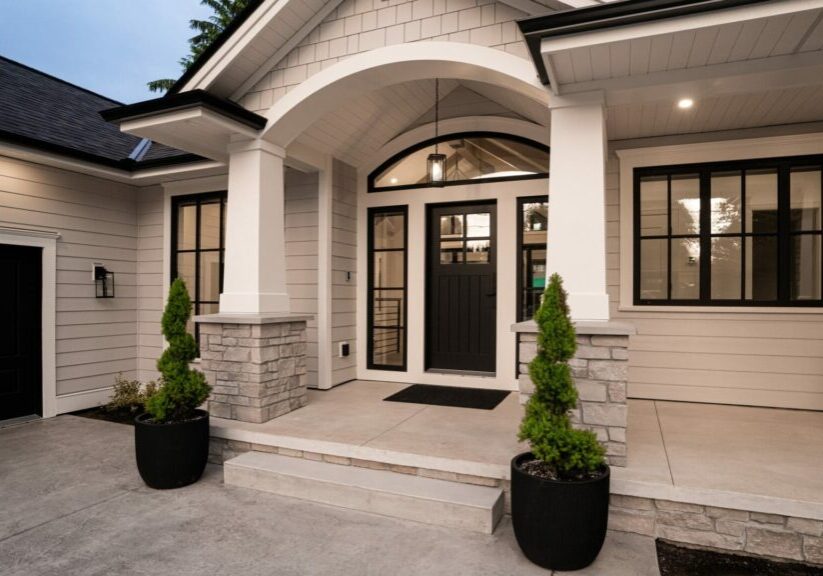
Modern farmhouse exteriors thrive on the thoughtful integration of siding with other elements. A harmonious blend of materials, colors, and architectural features creates a visually appealing and cohesive aesthetic. This section explores the importance of coordinating siding with windows, doors, and roofing to achieve a balanced and visually engaging design.
The effective integration of is paramount to achieving a successful outcome. Matching or contrasting colors and textures can significantly impact the overall visual impact. Understanding how different materials interact and how they can be coordinated with architectural styles is crucial for achieving a compelling final product.
Siding Coordination with Windows and Doors
Properly coordinating siding with windows and doors is essential for a balanced and aesthetically pleasing exterior. Windows and doors, often the focal points of a facade, should complement the siding in terms of color, texture, and material. Using a contrasting color for the window and door trim can accentuate these features, while similar colors can create a unified look. Consider the proportions of the windows and doors about the siding; large windows may require a wider trim, while smaller doors might look better with a subtle trim.
Siding Coordination with Roofing
Roofing is a major element in a modern farmhouse exterior. The roof’s material and color should be thoughtfully considered about the siding. Matching or contrasting colors between the roof and siding can create visual harmony or a bold statement. Using a complementary color scheme or a contrasting accent color can create a compelling and sophisticated exterior.
Visual Harmony and Balance
Creating visual harmony and balance in a modern farmhouse exterior involves carefully considering the proportions and elements. The siding should be sized and proportioned with other exterior features like windows, doors, and the roofline. Consider using contrasting or complementary colors to create a cohesive and visually balanced look. A balanced approach to siding, windows, doors, and a roof will create a visually engaging and attractive design.
Examples of Successful Siding Integration
exteriors often feature siding that integrates seamlessly with other exterior elements. One example might involve a house with light gray siding, dark gray trim, and a dark brown or charcoal roof. The use of complementary colors and textures creates a visually appealing and cohesive design. Another example might involve a house with white siding and black windows and doors, contrasting colors that emphasize these key features.
Techniques for Coordinating Siding with Exterior Features
Several techniques can be used to coordinate siding with other exterior features, including the following:
- Color Coordination: Using a color palette that complements the siding and other exterior elements, such as the roof and trim. Consider using a complementary or analogous color scheme to create a cohesive and visually appealing look. For example, a warm beige siding might pair well with a brown roof and complementary trim colors.
- Texture Matching: Matching the texture of the siding with other exterior elements, such as the roof or trim. Using different textures can create visual interest and depth. For instance, a smooth siding might pair well with a textured roof, while a wood-look siding might pair well with a natural wood trim.
- Proportioning: Considering the proportion of the siding about other exterior features, such as windows and doors. A large window might need a wider trim, while a smaller door might look better with a subtle trim. Proper proportions can create a balanced and visually appealing exterior.
- Material Coordination: Choosing siding materials that complement other exterior materials, such as the roof or trim. For instance, a house with a metal roof might benefit from metal or composite siding, creating a unified look.
Siding Material and Color Pairing with Architectural Styles
| Siding Material | Color | Architectural Style | Description |
|---|---|---|---|
| Wood | Light Beige | Traditional Farmhouse | Creates a classic and warm aesthetic. |
| Vinyl | Gray | Modern Farmhouse | Provides a clean and contemporary look. |
| Fiber Cement | Dark Gray | Contemporary Farmhouse | Offers durability and a sleek appearance. |
| Stone Veneer | Cream | Rustic Farmhouse | Adds a natural and rustic touch. |
Cost and Budget Considerations
Budgeting for a modern farmhouse siding project requires careful consideration of material costs, installation factors, and potential savings strategies. Understanding the price range of various siding types and the variables influencing installation costs is crucial for a realistic budget. This section details these aspects to ensure your project aligns with your financial goals.
Siding Material Cost Overview
Different siding materials vary significantly in cost. Fiber cement siding, known for its durability and aesthetic versatility, typically falls in the mid-range price category. Vinyl siding, a popular choice for its affordability and low maintenance, is usually the most budget-friendly option. Natural wood siding, while offering a classic look, tends to be the most expensive due to material sourcing, craftsmanship, and ongoing maintenance requirements. Metal siding, including steel and aluminum, offers a balance of durability and cost-effectiveness, often providing a middle ground between vinyl and fiber cement.
Factors Influencing Total Installation Costs
Several factors contribute to the total cost of siding installation beyond the material itself. The size of the house and the complexity of the siding design significantly impact labor costs. For example, a large, multi-level home with intricate architectural details will require more labor and potentially more specialized installers. Furthermore, site-specific conditions, like challenging terrain or the need for extensive prep work, can add to the overall installation expenses. The availability and cost of skilled labor in your area also play a role in the final price. Also, permitting fees and any necessary building code compliance will need to be included in the total project budget.
Budget-Friendly Siding Options
Selecting cost-effective siding options doesn’t necessitate compromising quality. Vinyl siding, for instance, offers excellent value for money. While vinyl might not match the aesthetic richness of other materials, its durability and low maintenance requirements make it a worthwhile choice for a budget-conscious homeowner. Additionally, careful consideration of siding styles can lead to cost savings. Simpler designs, while still maintaining the modern farmhouse aesthetic, can reduce the labor and material costs associated with complex installations. Finally, opting for less expensive but durable underlayments and insulation can also contribute to a more economical project without compromising the quality or longevity of the siding.
Cost-Effective Siding Examples
Vinyl siding, with its wide range of colors and styles, is a popular choice for its affordability. It requires minimal maintenance and offers excellent resistance to weather damage. Fiber cement siding, while slightly more expensive than vinyl, offers a higher level of durability and can mimic the look of natural wood, providing a stylish and resilient solution. A modern farmhouse aesthetic can be achieved with either of these options, showcasing that cost-effectiveness doesn’t have to equate to compromise. Using quality underlayments and insulation can contribute to a more economical project without sacrificing the quality or longevity of the siding.
Cost Comparison Table
| Siding Material | Approximate Cost Range (per square foot) | Approximate Labor Cost Range (per square foot) |
|---|---|---|
| Vinyl | $2-$5 | $3-$6 |
| Fiber Cement | $5-$10 | $4-$8 |
| Wood | $8-$20 | $5-$12 |
| Metal (Steel/Aluminum) | $6-$12 | $4-$7 |
Note: Prices are estimates and can vary based on specific material choices, local market conditions, and project complexity.
End of Discussion
In conclusion, choosing the right fence involves careful consideration of materials, design, and maintenance. This guide provides a structured approach to navigating the various options, empowering you to make informed decisions for your project. Ultimately, selecting the ideal siding ensures a beautiful and enduring exterior that perfectly reflects your vision.
